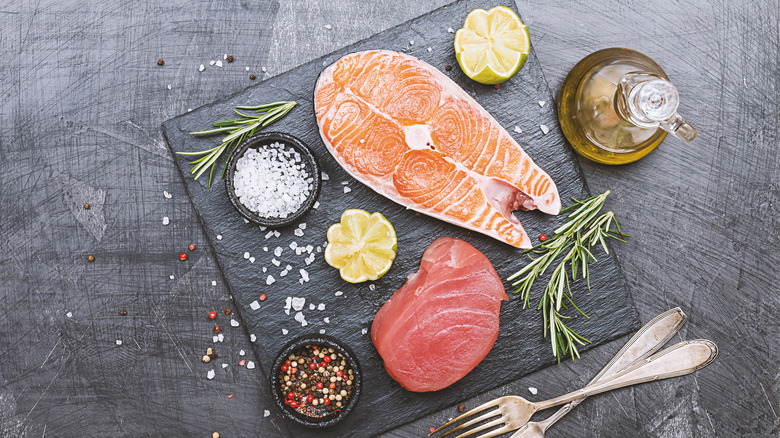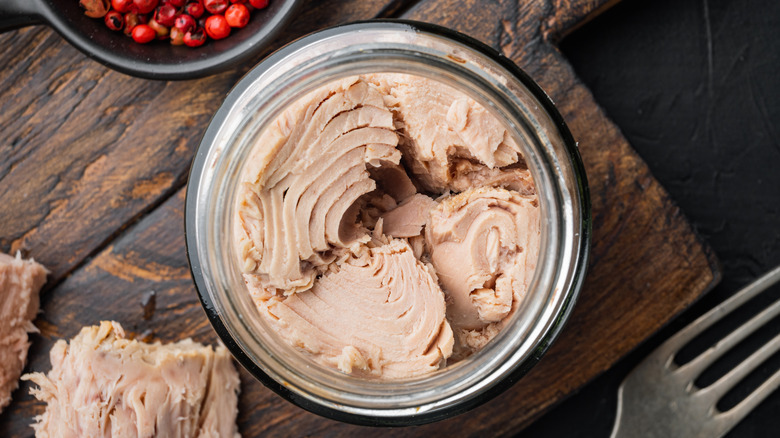Salmon Vs. Tuna: Which Should Be Your High-Protein Pick?
The Mediterranean diet and other healthy eating patterns rely heavily on fish while limiting meat and poultry. Moreover, the Dietary Guidelines for Americans recommend eating at least 8 ounces of fish and seafood weekly based on a 2,000-calorie diet. As the researchers note, fish is chock-full of protein, vitamin D, and omega-3s. The same goes for salmon and tuna, which are prized for their nutritional value. What makes them stand out is their high content of polyunsaturated fats and their distinct flavor.
In clinical trials, fish consumption has been shown to prevent or reduce inflammation and protect against chronic disease. Over time, it may improve cardiovascular health, boost immune function, and neutralize oxidative stress, according to a 2022 review published in the journal Fishes. For example, salmon is rich in tocopherols, a class of antioxidants that regulate cell function and gene expression. These compounds also exhibit neuroprotective, anti-tumor, and cholesterol-lowering effects. Zeaxanthin, astaxanthin, and other carotenoids in salmon may lower your risk of age-related diseases and metabolic disorders.
Tuna and salmon are higher in fat than other fish, but this doesn't mean they're less healthy. On the contrary, they pack a hefty nutritional punch. They're both high in protein, which increases satiety and keeps your metabolism up while preserving lean mass, explains a 2018 review featured in the journal Frontiers in Endocrinology. That said, which one is healthier?
Nutritional differences between salmon and tuna
Tuna and salmon are some of the best fish to eat, but each has a different nutritional profile. For example, wild salmon provides around 142 calories, 20 grams of protein, and 6.3 grams of fat, including 1.7 grams of omega-3s, per 3.5 ounces (via Nutrition Value). By comparison, farmed Atlantic salmon has 206 calories, 22 grams of protein, and 12.4 grams of fat, including 2.5 grams of omega-3 essential fats per 3.5 ounces, according to MyFoodData.
Raw tuna, on the other hand, delivers 144 calories, 23 grams of protein, and 4.9 grams of fat, including 1.3 grams of omega-3s per 3.5 ounces. If you prefer canned tuna packed in oil, you'll get 186 calories, 26 grams of protein, and 8 grams of fat, including 263 milligrams of omega-3s per 3.5 ounces. Apart from that, tuna has less calcium, potassium, folate, and vitamin D than salmon. By contrast, raw tuna contains higher amounts of iron, zinc, vitamin A, and vitamin B12 than salmon and canned tuna, per MyFoodData.
Except for oil-packed varieties, tuna is lower in calories than salmon. The latter, however, boasts higher doses of healthy fats. Both farmed and wild salmon are higher in cholesterol than tuna, but that's not necessarily a reason for concern. "The body creates cholesterol in amounts much larger than what you can eat, so avoiding foods that are high in cholesterol won't affect your blood cholesterol levels very much," cardiologist Steven Nissen told the Cleveland Clinic.
Which option is better for your health?
Both salmon and tuna, whether fresh or canned, can be part of a balanced diet. However, salmon is slightly more nutritious and poses fewer risks than tuna, which can contain more mercury than salmon.
The U.S. Food and Drug Administration (FDA) recommends two servings of salmon per week, as this fish is low in mercury. The same goes for canned light tuna. By comparison, albacore (white) and yellowfin tuna are higher in mercury and should be consumed less often. Bigeye tuna has the highest mercury levels.
From a culinary perspective, both types of fish are easy to cook and can be used in a multitude of recipes. You can even swap one for the other in fish stews, salads, fish pies, or pasta dishes. For example, this traditional tuna salad recipe calls for white tuna packed in water, but you can just as well use smoked salmon.


